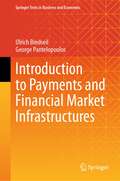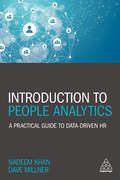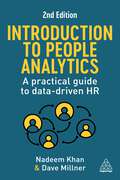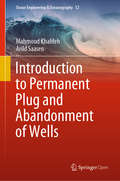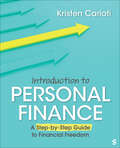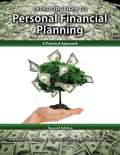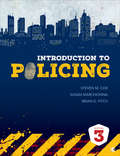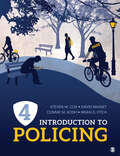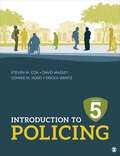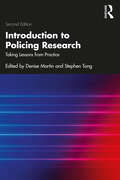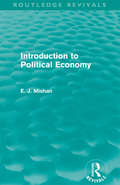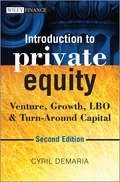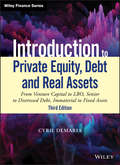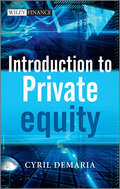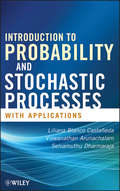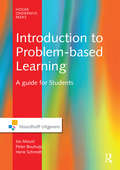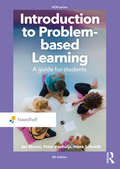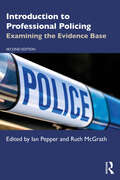- Table View
- List View
Introduction to Payments and Financial Market Infrastructures (Springer Texts in Business and Economics)
by Ulrich Bindseil George PantelopoulosPayments and financial market infrastructures are vital components of modern economies, yet they have often been overlooked by economists. However, any economic exchange, including financial market transactions, is matched by a payment leg, and the safety, efficiency, and immediacy of the payment, and the problem of linking the two legs of the transaction (“delivery-vs-payment”), remain universal challenges. The consequences of inefficiencies or interruptions in payment and settlement systems have immediate and significant impacts on the real economy. Moreover, payments and financial market infrastructures are also a matter of strategic importance for nation-states, and being excessively dependent on foreign providers has been proven to be a significant risk, as they can be “weaponized."This book provides a concise yet thorough introduction to payments and financial market infrastructures, exploring various types of risks, retail payments, payment systems, cross-border payments, central counterparties, FX operations, and central securities depositories. The final chapter investigates payment innovations, including unbacked crypto-assets (e.g. Bitcoin), stablecoins, and central bank digital currencies. The text outlines key activities and risk management frameworks, as well as examining the operational mechanics of different payment systems. The book emphasizes the importance of understanding the nature of transfer of financial claims and liabilities through the process of payment and settlement, providing financial account representations of payments wherever useful. The book concludes that the payment and financial market infrastructure space has been shaken by recent innovations, which are expected to lead to seismic shifts in payment technology, practices, and market structures.
Introduction to People Analytics: A Practical Guide to Data-driven HR
by Nadeem Khan Dave MillnerAn understanding of people analytics is a crucial skill for all HR professionals. No longer limited to employees in data teams or those with analyst in their job titles, people analytics is now an integral part of every HR job. Introduction to People Analytics allows all HR professionals to get to grips with analytics, feel confident in their ability to handle employee and organizational data and use analytics to move from opinions to insights.From where to find data in an organization, how to collect it and analyse it through to how to use these findings to add business value, Introduction to People Analytics is essential reading for all HR professionals. With case studies and thought leadership insights from companies who have leveraged people analytics to improve culture and employee engagement, increase performance and reduce costs including NHS, Brompton Bikes, British Heart Foundation, King, Experian and AstraZeneca, FIS and Swarovski, this book shows how and where HR analytics can make a tangible difference to organizations. There is also expert guidance and practical advice on how to embed analytics into HR processes and adopt a data-driven approach to all workplace activities.
Introduction to People Analytics: A Practical Guide to Data-driven HR
by Nadeem Khan Dave MillnerHow can HR practitioners with little or no experience of analytics feel confident in their ability to find, analyse and use workforce data to make better business decisions? This book has the answers.An understanding of people analytics is a crucial skill for all HR professionals. This new edition provides expert guidance on the key aspects of analytics, enabling all HR professionals to feel confident in their ability to handle employee and organizational data. It features new material on applying data to respond to external disruption such as COVID-19 as well as how to develop a people analytics journey. There is also advice on recruiting people analytics specialists and embedding new data-driven operating models within HR.This book is essential reading for all HR professionals to develop understanding of how and where HR analytics can make a tangible difference to organizations. With updated case studies and thought leadership examples from companies including NHS, AstraZeneca and Swarovski, this book demonstrates how people analytics can be leveraged to improve culture and employee engagement, increase performance and reduce costs.
Introduction to Permanent Plug and Abandonment of Wells (Ocean Engineering & Oceanography #12)
by Mahmoud Khalifeh Arild SaasenThis open access book offers a timely guide to challenges and current practices to permanently plug and abandon hydrocarbon wells. With a focus on offshore North Sea, it analyzes the process of plug and abandonment of hydrocarbon wells through the establishment of permanent well barriers. It provides the reader with extensive knowledge on the type of barriers, their functioning and verification. It then discusses plug and abandonment methodologies, analyzing different types of permanent plugging materials. Last, it describes some tests for verifying the integrity and functionality of installed permanent barriers. The book offers a comprehensive reference guide to well plugging and abandonment (P&A) and well integrity testing. The book also presents new technologies that have been proposed to be used in plugging and abandoning of wells, which might be game-changing technologies, but they are still in laboratory or testing level. Given its scope, it addresses students and researchers in both academia and industry. It also provides information for engineers who work in petroleum industry and should be familiarized with P&A of hydrocarbon wells to reduce the time of P&A by considering it during well planning and construction.
Introduction to Personal Finance: A Step-by-Step Guide to Financial Freedom (Corwin Mathematics Series)
by Kristen CariotiIntroduction to Personal Finance invites students to reflect on their values and behaviors with money and to set goals to reach financial freedom. Author Kristen Carioti provides clear, step-by-step guidance on the essential building blocks, from setting up an emergency fund, to navigating student loans and investing for retirement. Students are encouraged to evaluate their personal relationship with money and mindfully assess their behavior so they can set and reach achievable financial goals. Watch this video walkthrough and see how Vantage works:
Introduction to Personal Finance: A Step-by-Step Guide to Financial Freedom (Corwin Mathematics Series)
by Kristen CariotiIntroduction to Personal Finance invites students to reflect on their values and behaviors with money and to set goals to reach financial freedom. Author Kristen Carioti provides clear, step-by-step guidance on the essential building blocks, from setting up an emergency fund, to navigating student loans and investing for retirement. Students are encouraged to evaluate their personal relationship with money and mindfully assess their behavior so they can set and reach achievable financial goals. Watch this video walkthrough and see how Vantage works:
Introduction to Personal Financial Planning: A Practical Approach
by David B. Stewart Alexander G. Kondeas Nicholas A. DavesA practical approach to introduction to personal financial planing
Introduction to Policing
by Susan Marchionna Steven M. Cox Brian D. FitchIntroduction to Policing, Third Edition continues to focus on the thought-provoking, contemporary issues that underscore the challenging and rewarding world of policing. Steven M. Cox, Susan Marchionna, and experienced law enforcement officer Brian D. Fitch balance theory, research, and practice to give students a comprehensive, yet concise, overview of both the foundations of policing and the expanded role of today’s police officers. The accessible and engaging writing style, combined with stories from the field, make policing concepts and practices easy for students to understand and analyze. Unique coverage of policing in multicultural communities, the impact of technology on policing, and extensive coverage of policing strategies and procedures — such as those that detail the use of force —make this bestselling book a must-have for policing courses.
Introduction to Policing
by Susan Marchionna Steven M. Cox Brian D. FitchIntroduction to Policing, Third Edition continues to focus on the thought-provoking, contemporary issues that underscore the challenging and rewarding world of policing. Steven M. Cox, Susan Marchionna, and experienced law enforcement officer Brian D. Fitch balance theory, research, and practice to give students a comprehensive, yet concise, overview of both the foundations of policing and the expanded role of today’s police officers. The accessible and engaging writing style, combined with stories from the field, make policing concepts and practices easy for students to understand and analyze. Unique coverage of policing in multicultural communities, the impact of technology on policing, and extensive coverage of policing strategies and procedures — such as those that detail the use of force —make this bestselling book a must-have for policing courses.
Introduction to Policing
by Steven M. Cox Brian D. Fitch David W. Massey Connie M. KoskiWritten and extensively updated by an author team that includes former and current law enforcement officers, Introduction to Policing focuses on the thought-provoking, contemporary issues that underscore the challenging and rewarding world of policing. The authors skillfully balance research and practice to offer readers an overview of both the foundations of policing and the expanded role of today’s police officers. Evolving with the modern realities of the field, the Fourth Edition discusses major new and ongoing impactful events, such as the political shift marked by the U.S. presidential election of 2016 and expanded coverage of women and minorities in policing. The accessible and engaging writing style, coupled with unique coverage of the issues of policing in multicultural communities, the impact of technology on policing, and policing strategies and procedures, make this bestselling book a must-have.
Introduction to Policing
by Steven M. Cox Brian D. Fitch David W. Massey Connie M. KoskiWritten and extensively updated by an author team that includes former and current law enforcement officers, Introduction to Policing focuses on the thought-provoking, contemporary issues that underscore the challenging and rewarding world of policing. The authors skillfully balance research and practice to offer readers an overview of both the foundations of policing and the expanded role of today’s police officers. Evolving with the modern realities of the field, the Fourth Edition discusses major new and ongoing impactful events, such as the political shift marked by the U.S. presidential election of 2016 and expanded coverage of women and minorities in policing. The accessible and engaging writing style, coupled with unique coverage of the issues of policing in multicultural communities, the impact of technology on policing, and policing strategies and procedures, make this bestselling book a must-have.
Introduction to Policing
by Steven M. Cox David W. Massey Connie M. Koski Ericka WentzWritten by an author team that includes former and current law enforcement officers, Introduction to Policing focuses on the most thought-provoking, contemporary issues in the world of policing. The authors tackle complex issues that impact policing today, such as social diversity; advancements in technology; and global issues, such as terrorism and transnational organized crime. The Fifth Edition offers fully updated content in SAGE’s Vantage courseware platform. This title is accompanied by a complete teaching and learning package. Contact your SAGE representative to request a demo. Learning Platform / Courseware SAGE Vantage is an intuitive learning platform that integrates quality SAGE textbook content with assignable multimedia activities and auto-graded assessments to drive student engagement and ensure accountability. Unparalleled in its ease of use and built for dynamic teaching and learning, Vantage offers customizable LMS integration and best-in-class support. It’s a learning platform you and your students will actually love. Learn more. Assignable Video with Assessment Assignable video (available in SAGE Vantage) is tied to learning objectives and curated exclusively for this text to bring concepts to life. Watch a sample video now. LMS Cartridge: Import this title’s instructor resources into your school’s learning management system (LMS) and save time. Don’t use an LMS? You can still access all of the same online resources for this title via the password-protected Instructor Resource Site. Learn more.
Introduction to Policing
by Steven M. Cox David W. Massey Connie M. Koski Ericka WentzWritten by an author team that includes former and current law enforcement officers, Introduction to Policing focuses on the most thought-provoking, contemporary issues in the world of policing. The authors tackle complex issues that impact policing today, such as social diversity; advancements in technology; and global issues, such as terrorism and transnational organized crime. The Fifth Edition offers fully updated content in SAGE’s Vantage courseware platform. This title is accompanied by a complete teaching and learning package. Contact your SAGE representative to request a demo. Learning Platform / Courseware SAGE Vantage is an intuitive learning platform that integrates quality SAGE textbook content with assignable multimedia activities and auto-graded assessments to drive student engagement and ensure accountability. Unparalleled in its ease of use and built for dynamic teaching and learning, Vantage offers customizable LMS integration and best-in-class support. It’s a learning platform you and your students will actually love. Learn more. Assignable Video with Assessment Assignable video (available in SAGE Vantage) is tied to learning objectives and curated exclusively for this text to bring concepts to life. Watch a sample video now. LMS Cartridge: Import this title’s instructor resources into your school’s learning management system (LMS) and save time. Don’t use an LMS? You can still access all of the same online resources for this title via the password-protected Instructor Resource Site. Learn more.
Introduction to Policing Research: Taking Lessons from Practice
by Stephen Tong Denise MartinThis book offers a first-hand insight into the work of policing scholars and the research that they undertake. Bringing together a range of leading scholars and drawing on a range of pressing topics, it introduces the diverse nature of policing research, and the ethical and practical challenges faced by policing researchers. Each chapter brings clarity to the concept of empirical research within policing, introduces readers to the theoretical explanations and assumptions that underpin the rational of research design in policing, as well as considering the limitations of research. Topics include: • research methods in police research; • police professionalisation; • police and diversity; • police leadership; • undercover policing; • police and vulnerability; • activist research; • social media and policing. This revised and expanded new edition includes more focus on the role of research in policing, police and academic partnerships and practitioners as researchers, as well as a brand new section offering international perspectives on policing research. Brimming with practical examples, case studies, key learning points and practical advice, this book is essential reading for Professional Policing students, as well as early-career researchers and those engaged with criminological research methods.
Introduction to Political Economy
by David N. Balaam Michael VesethHistory and overview of political economy
Introduction to Political Economy: Introduction To Political Economy (Routledge Revivals)
by E. J. MishanFirst published in 1982, Introduction to Political Economy is a clear and concise introduction to the normative aspects of economics by one of the world’s leading authorities on the subject. In this highly readable book, Professor Mishan takes the student to the heart of the subject without recourse to algebra and with only the simplest of diagrams. The author carefully distinguishes the various meanings of the terms political economy, normative economics, welfare economics and allocative economics. He considers the standard allocation rules and the crucial concepts of consumer surplus and rent, which are so important to cost-benefit analysis, while then going on to resolve the paradoxes of the efficiency criterion. Lastly, Professor Mishan assesses both the social worth of radical conservatism, which is associated with the Chicago School of Economics, and the relevance of the modern theory of welfare economics to social welfare.
Introduction to Portfolio Theory
by Andre F. PeroldIntroductory note describing the basic building blocks of Markowitz's mean-variance portfolio theory.
Introduction to Private Equity
by Cyril DemariaIntroduction to Private Equity is a critical yet grounded guide to the private equity industry. Far more than just another introductory guide, the book blends academic rigour with practical experience to provide a critical perspective of the industry from a professional who has worked at many levels within the industry, including insurance, funds of funds, funds and portfolio companies.The book looks at private equity from the point of view of the individual or the business. How is a private business valued? How is the acquisition transaction processed? What are the due diligence issues that should be considered before moving ahead? A valuable insight to a rather opaque market.Introduction to Private Equity covers the private equity industry as a whole, highlighting its historical development in order to put its recent development into perspective. The book covers its organization, governance and function, then details the various segments within the industry, including LBO, Venture Capital, Mezzanine Financing, Growth Capital and beyond. Finally, it offers a framework to anticipate and understand its future developments.It provides a balanced perspective on the current corporate governance challenges which are affecting the industry and draws perspective to understand the evolution of the sector, following one of its major crises.
Introduction to Private Equity, Debt and Real Assets: From Venture Capital to LBO, Senior to Distressed Debt, Immaterial to Fixed Assets (Wiley Finance)
by Cyril DemariaFully revised and updated to reflect changes in the private equity sector Building on and refining the content of previous editions, Introduction to Private Equity, Debt and Real Assets, Third Edition adopts the same logical, systematic, factual and long-term perspective on private markets (private equity, private debt and private real assets) combining academic rigour with extensive practical experience. The content has been fully revised to reflect developments and innovations in private markets, exploring new strategies, changes in structuring and the drive of new regulations. New sections have been added, covering fund raising and fund analysis, portfolio construction and risk measurement, as well as liquidity and start-up analysis. In addition, private debt and private real assets are given greater focus, with two new chapters analysing the current state of these evolving sectors. • Reflects the dramatic changes that have affected the private market industry, which is evolving rapidly, internationalizing and maturing fast • Provides a clear, synthetic and critical perspective of the industry from a professional who has worked at many levels within the industry • Approaches the private markets sector top-down, to provide a sense of its evolution and how the current situation has been built • Details the interrelations between investors, funds, fund managers and entrepreneurs This book provides a balanced perspective on the corporate governance challenges affecting the industry and draws perspectives on the evolution of the sector.
Introduction to Private Equity: Venture, Growth, Lbo And Turn-around Capital (The Wiley Finance Series #506)
by Cyril DemariaIntroduction to Private Equity is a critical yet grounded guide to the private equity industry. Far more than just another introductory guide, the book blends academic rigour with practical experience to provide a critical perspective of the industry from a professional who has worked at many levels within the industry, including insurance, funds of funds, funds and portfolio companies. The book looks at private equity from the point of view of the individual or the business. How is a private business valued? How is the acquisition transaction processed? What are the due diligence issues that should be considered before moving ahead? A valuable insight to a rather opaque market. Introduction to Private Equity covers the private equity industry as a whole, highlighting its historical development in order to put its recent development into perspective. The book covers its organization, governance and function, then details the various segments within the industry, including LBO, Venture Capital, Mezzanine Financing, Growth Capital and beyond. Finally, it offers a framework to anticipate and understand its future developments. It provides a balanced perspective on the current corporate governance challenges which are affecting the industry and draws perspective to understand the evolution of the sector, following one of its major crises.
Introduction to Probability and Stochastic Processes with Applications
by Liliana Blanco Castañeda Viswanathan Arunachalam Selvamuthu DharmarajaAn easily accessible, real-world approach to probability and stochastic processesIntroduction to Probability and Stochastic Processes with Applications presents a clear, easy-to-understand treatment of probability and stochastic processes, providing readers with a solid foundation they can build upon throughout their careers. With an emphasis on applications in engineering, applied sciences, business and finance, statistics, mathematics, and operations research, the book features numerous real-world examples that illustrate how random phenomena occur in nature and how to use probabilistic techniques to accurately model these phenomena.The authors discuss a broad range of topics, from the basic concepts of probability to advanced topics for further study, including Itô integrals, martingales, and sigma algebras. Additional topical coverage includes:Distributions of discrete and continuous random variables frequently used in applicationsRandom vectors, conditional probability, expectation, and multivariate normal distributionsThe laws of large numbers, limit theorems, and convergence of sequences of random variablesStochastic processes and related applications, particularly in queueing systemsFinancial mathematics, including pricing methods such as risk-neutral valuation and the Black-Scholes formulaExtensive appendices containing a review of the requisite mathematics and tables of standard distributions for use in applications are provided, and plentiful exercises, problems, and solutions are found throughout. Also, a related website features additional exercises with solutions and supplementary material for classroom use. Introduction to Probability and Stochastic Processes with Applications is an ideal book for probability courses at the upper-undergraduate level. The book is also a valuable reference for researchers and practitioners in the fields of engineering, operations research, and computer science who conduct data analysis to make decisions in their everyday work.
Introduction to Problem-Based Learning
by Jos Moust P. Bouhuijs Hans SchmidtAre you a student about to enrol on a Problem-based Learning course? Or are you currently engaged in Problem-based Learning and want to get the most out of your course? Are you tutoring a course in Problem-based education? This book will help you understand this popular learning method. It enables students and teachers to experience the full potential of Problem-based Learning. Introduction to Problem-based Learning pays particular attention to the skills students need to operate within, as well as outside of Problem-based groups.
Introduction to Problem-Based Learning (Routledge-Noordhoff International Editions)
by Henk Schmidt Jos Moust Peter BouhuijsIntroduction to Problem-based Learning teaches students how to work with the problem-based learning method, which requires mainly self-directed learning. Particular attention is given to the necessary skills to apply this method effectively. Why Introduction to Problem-based Llearning? • comprehensible introduction in the problem-based learning method • enables students to experience the full potential of this concept • discusses the use of digital devices Introduction to Problem-based learning provides students with the necessary skills to operate within as well as outside problem-based groups. It discusses issues like: How do you take on a problem? How do you collaborate with others? How do you deal with cultural diversity? How do you lead a tutorial group? How can you organize your studies best? Special attention is given to the use of computers, tablets and internet in a problem-based environment.
Introduction to Professional Policing: Examining the Evidence Base
by Ian PepperPolicing is a dynamic profession with increasing demands and complexities placed upon police officers, staff and volunteers who provide a 24-hour service across a diverse range of communities. Written by experts in policing higher education from across both academic and professional practice, this book equips aspiring or newly appointed police officers, staff and volunteers with the knowledge and understanding to deal with the significant and often complex challenges they face daily.This second edition of Introduction to Professional Policing explores a number of the core underpinning knowledge requirements identified as themes within the ever-evolving National Policing Curriculum (NPC) and Police Constable Entry Routes (PCER), while also informing those embarking on leadership development. These include: Community and neighbourhood policing Counter-terrorism Digital policing Ethics, equality, diversity and inclusion Evidence-based policing Maintaining professional standards Police leadership Problem solving and problem-oriented policing Victims and protecting the vulnerable Volunteers in policing This edition has been reviewed and significantly updated in line with the dynamic and ongoing demands faced by operational policing and therefore the associated knowledge requirements for policing education and training. The book is refocused on the learning requirements contained within the range of entry routes now available in to policing, as well as the professional development of those serving as police staff and volunteers. This includes new chapters providing insights into community and neighbourhood policing, problem solving and volunteers in policing.At the end of each chapter the student finds a case study, reflective questions and an extensive reference list, all of which reinforces students’ knowledge and furthers their professional development. Written in a clear and direct style, this book supports aspiring police officers, newly appointed police officers, direct entry detectives, community support officers, special constables and police staff. It will also be of interest to those embarking on a leadership journey within policing and anyone wanting to learn more about the profession of policing. It is essential reading for students taking a professional policing degree or commencing any of the police constable entry routes.
Introduction to Project Finance in Renewable Energy Infrastructure: Including Public-Private Investments and Non-Mature Markets
by Farid MohamadiWhat is project finance? What makes project or structured finance so relevant for large renewable energy infrastructure? Which vocabulary do I need to know in order to speak the same language during meetings with lawyers, investors, bankers and engineers? These questions and many more are answered throughout this book, offering real world examples to bridge the gap between theory and practice. The book details the role of each stakeholder in the development of renewable energy projects, the interconnection between all the agreements, the financial process from fundraising to financial close, the processes of due diligence, risk analysis, project investment valuation and much more. It also provides with an introduction to Portfolio Management using renewable energy assets and an explanation of the role of Climate Finance in green energy investments. The commented glossary enables readers to unpick the jargon used in project finance for renewable energy, and the numerous creative figures and comprehensive tables aid with understanding. Offering a complete picture of the discipline, Introduction to Project Finance in Renewable Energy Infrastructure will be of value to professionals, engineers and academics alike interested in understanding the process and components of project finance in renewable energy infrastructures, in both private and public-private contexts.
